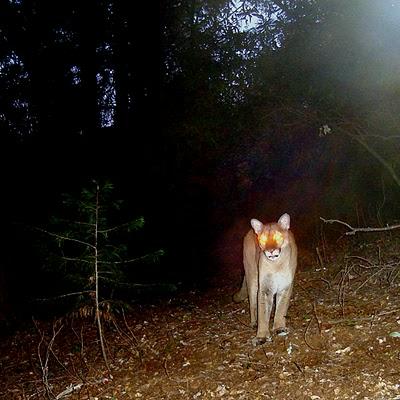There are many predators of the white-tailed deer, but none is as exciting or mysterious as the famed mountain lion. Mountain lions are big cats that can effectively take down any size deer, buck or doe, both sick or healthy. A mountain lion requires about 8 to 10 pounds of meat per day to survive. The lion’s diet consists of mule deer, elk, small mammals, livestock, white-tailed deer and even pets.
Generally speaking, mountain lions prefer deer. Research has found that mountain lions can kill a deer about every 9 to 14 days, but in some locations it has been found that a lion kills as many as two deer per week, especially in hot weather. This is because many other secondary predators and scavengers move into to consume what the lion has left, forcing the lion to hunt sooner than it would have consumed the kill by itself.

Source: “Once mountain lions inhabited the entire US it was believed that whitetails were a big part of their diet. Today, most mountain lions, also known as cougars or pumas, solely inhabit the Western US, where they prey upon the mule deer. However, in the Northern US and other isolated areas, mountain lion still stumble upon a few whitetails from time to time. Whitetail deer are also beginning to more westward and as a result, may become a larger part of the mountain lions diet in a few years.
Once it spots a deer, the mountain lion will quietly stalk it until it slowly closes the distance to within about 10 yards. Then, with a swift charge, it will pounce on the deer’s back, attempting to sink its sharp teeth into the deer’s neck. The weight and strength of the lion, along with the delivered wound, render the deer dead in a few minutes. Mountain lions usually attack from above in an effort to knock the deer on the ground.
Immediately after killing the deer, the lion will usually expose the guts and eat them. It will then drag the carcass to a safe hiding place where it will feed on it over the course of a few days. On average, a mountain lion needs to kill a deer every 4 to 6 days.
Although they are capable of killing the largest bucks with ease, mountain lions will usually target younger, weaker, and malnourished deer first. This helps the lion conserve its energy, especially during the winter, when energy is precious. A lion will only attack a large deer if it absolutely must.”
Mountain lions usually carry or drag their prey to a secluded area under cover to feed. As one would expect, drag marks are frequently found at fresh kill sites. Lions generally begin feeding on internal organs such as the liver, heart, and lungs first. They typically enter through the abdomen or thorax when first consuming a kill, but some feed on the neck, shoulder or hindquarters first. At many lion kills sites, the stomach of the deer will be removed and found buried nearby.
Mountain lions frequently try to cache their kill by covering it with soil, leaves, grass and sticks. Lions may eviscerate prey and cover the viscera separately from the rest of the carcass. Even where little debris is available, bits of soil, rock, grass or sticks may be found on the carcass. Mountain lions are efficient predators of deer and have no problem taking mature bucks. They are strong and can move their kills quite a substantial distance.

